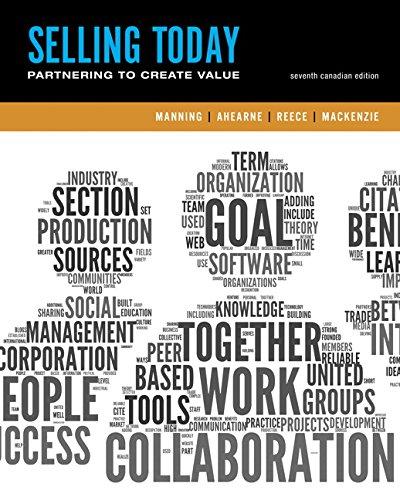Dave Levitt, featured at the beginning of this chapter, is a regional sales manager for Salesforce.com .
Question:
Dave Levitt, featured at the beginning of this chapter, is a regional sales manager for Salesforce.com . The CRM solution provider is exclusively a cloud-computing vendor offering hosted applications. This model sets the company apart from competitors such as SAP, Oracle, or Microsoft, who are predominantly on-premise providers.
Cloud-computing systems have a high degree of flexibility as they can be customized for each individual account and implemented within a very short time frame. Salesforce.
com ’s unique selling proposition is therefore closely linked to the speed with which a client can gain the benefit: Cloud-computing implementation times are typically weeks or months, whereas competitive on-premise solutions can take years to be implemented. Therefore, the total cost of ownership is much lower, and the ROI is much higher and comes in faster.
Before getting in touch with a prospect, Levitt’s sales representatives typically spend a substantial amount of time preparing for a sales call and keeping up with news releases. Such upfront investigative work is necessary to uncover such things as changes in top management or factors that are driving a company to change a business model. Working for a CRM company, Salesforce.com ’s salespeople have comprehensive access to additional news and information about each of their customers and prospects. Hence, by the time representatives have decided to pick up the phone to prospect, they already have a sense for why they are calling and what the value proposition is going to be specifically for that account.
For providers of enterprise software solutions, it is important to have contacts and relationships with three different types of individuals within the prospective customer company: (1) executive financial influencers who have ultimate responsibility for the budget and the project itself, (2) a coach who can give guidance on a day-to-day basis, and (3) IT specialists who can facilitate the process and who would be the custodians after the implementation of the solution. Therefore, the sales representative has to be an orchestrator of resources within Salesforce.com for different buying influencers in the prospect’s organization at different points in the sales cycle. For example, the salesperson would include a technical employee from Salesforce.com as part of the sales team who could apply the customer’s needs to the product itself and perform demonstrations of software.
One would also need to incorporate an internal sales executive that aligns with the customer’s executive.
Furthermore, the internal services organization or a thirdparty implementation partner is needed to explain and execute the implementation of the product. There could also be a wide variety of other specialists, depending on which specific tasks have to be accomplished.
Typically, the sales representative would start to qualify the opportunity through conversations with the coach. Using various questioning techniques during the initial discovery process, the sales representative has to understand the following: What is the prospect’s business model? Why might the prospect be interested in our offerings? What is their problem and how big is it? What is the complexity of the problem the prospect is trying to address? Will there be a good fit? Is it worth investing the time and money it takes to win the account? What is their time frame? How are they going to measure success?
If the initial discovery shows that the problem can be addressed, the sales representative would then ask for access to the ultimate decision maker and all the other key stakeholders. Then she would perform a similar discovery as was done with the first person (i.e., the coach), constantly trying to qualify the value of the service solution offering and making sure that it is worth pursuing the opportunity (as, for large opportunities, it could be a one-year investment to win it). So the sales representative has to make sure and qualify that (1) it is a legitimate opportunity, (2) it can be won, and (3) it is worth winning. As Levitt emphasizes, it has to be a win-win perspective: “We do not sell a commodity, but a specialty.
We do not compete on price alone, but on quality and value.”
Questions
1. Imagine you are in the position of Dave Levitt, selling CRM services to different business clients. What would be the most promising sources of prospects for you?
2. What criteria does Dave Levitt use for qualifying the prospect?
3. What questions does Dave Levitt ask to understand the needs of the customer?
4. What product features does Dave Levitt highlight that will help a user of Salesforce.com improve his business?
5. Does it appear that Dave Levitt is utilizing previously collected sales intelligence to impress the potential buyer with insights that are above and beyond the product features and benefits? Please specify.
Step by Step Answer:

Selling Today Partnering To Create Value
ISBN: 9780133156850
7th Canadian Edition
Authors: Gerald L. Manning





